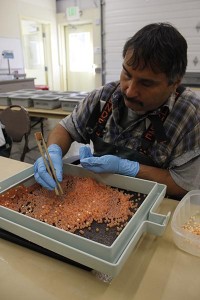
Source: Northwest Indian Fisheries Commission
Pink salmon are the most abundant salmon species in the Northwest, but the Lower Elwha Klallam Tribe didn’t want to risk losing the Elwha River pink population with the current removal of the river’s two fish-blocking dams.
The deconstruction of the Elwha and Glines Canyon dams are part of the massive project to restore the Elwha River after nearly 100 years of blocked flows and degraded salmon habitat. One result of the project is that high levels of sediment once trapped trapped behind the dams are now flowing downriver.
“We weren’t sure how the pinks were going to be affected by the dam deconstruction activity, so we wanted to take precautions to protect them,” said Larry Ward, the tribe’s hatchery manager. “The historical population of pinks in the Elwha River was 400,000 to 600,000. The current run is 200, making it a chronically depressed stock of fish.”
While pinks have a lower commercial value, they play an important role in a properly functioning ecosystem by providing food for other animals and contributing nutrients to the watershed.
“The habitat in the lower river for pinks wasn’t great when the dams were in place, but they were using it,” Ward said.
Pinks returning to the Elwha River in 2011 were collected and spawned. The fertilized eggs were incubated at the Washington Department of Fish and Wildlife’s (WDFW) Hurd Creek Hatchery, then sent to the National Oceanic and Atmospheric Administration’s (NOAA) Manchester Research Station, where they were reared to adults. The fish, 300 males and 132 females, were then brought back to Elwha in August for spawning.
A portion of the fertilized eggs from this fall’s spawning will go back into the pink salmon broodstock program, while the rest will be reared to smolts and released from the Elwha Hatchery into the river in spring 2014. The broodstock program is expected to continue through the 2015 pink salmon cycle.
The tribe’s partners in this program are NOAA, WDFW, Olympic National Park, Northwest Indian Fisheries Commission and citizen volunteers.
